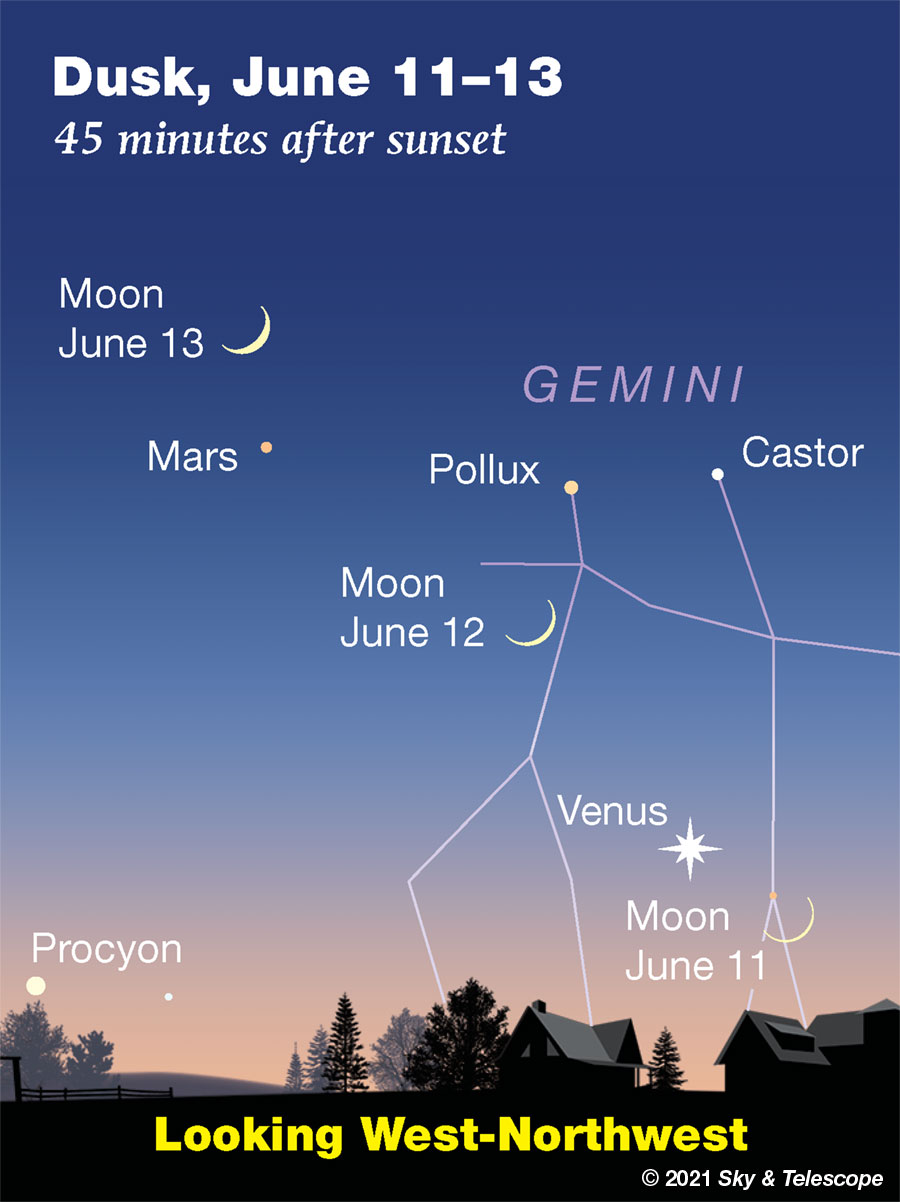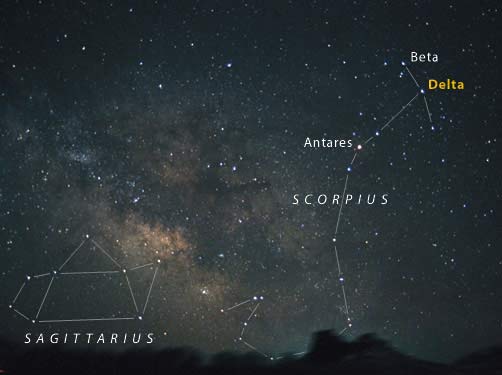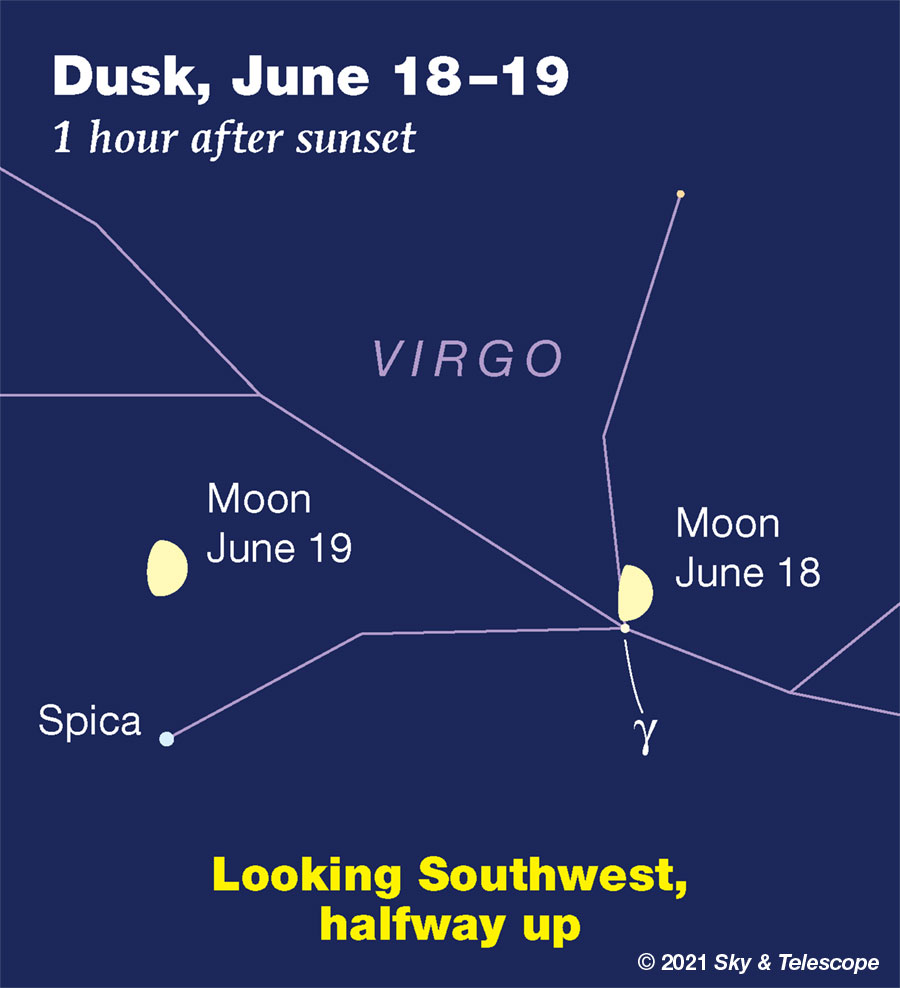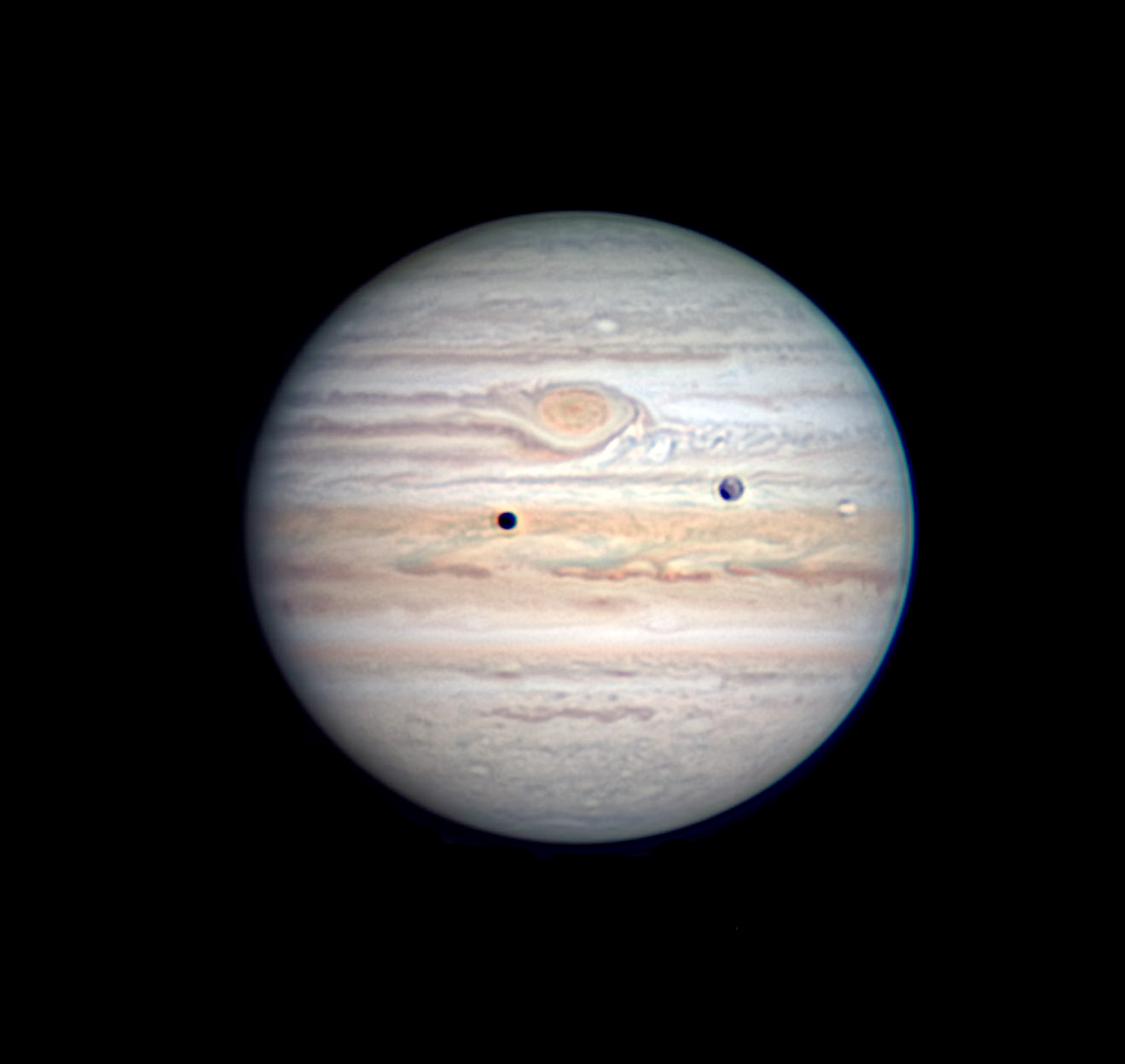Nova Cassiopeiae still continues. It's been 12 weeks since Nova Cas 2021 erupted to magnitude 7.7. Surprisingly, it has stayed roughly that bright ever since — except for swelling to 5.3, faint naked-eye visibility, for a week in early-mid May before dropping back to 7.7. As of June 17th it had crept back up to 6.8.
The nova is moderately high in the north-northeast after dark, depending on your latitude. It climbs higher through the night and stands very high before dawn. Charts and comparison stars.
And now, Nova Herculis. On June 12th Seiji Ueda of Japan discovered an 8.4-magnitude nova at the Hercules-Aquila border. Within hours Nova Herculis 2021 reached 6.3, then began fading fast. As of June 17th it was down to 9.5 visually. It's distinctly red. See Bob King's Bright Nova in Hercules on a Roller Coaster Ride, with charts.
FRIDAY, JUNE 11
■ Bright Venus and the thin crescent Moon form a mystic pair low in the west-northwest in twilight, as shown below. They'll be 3° or 4° apart for skywatchers near the US East Coast, and only 2° apart by the time of twilight for the West Coast. Your best view might be about 35 to 45 minutes after sunset, before they get too low.

SATURDAY, JUNE 12
■ The Big Dipper hangs high in the northwest right after dark. The Dipper's Pointers, currently its bottom two stars, point lower right toward Polaris. Above Polaris, and looking very similar to it, is Kochab, the lip of the Little Dipper's bowl.
Kochab stands precisely above Polaris around the end of twilight or a little after. How precisely can you time this event for your location, perhaps using the vertical edge of a building?
■ After dark, look south-southeast for orange Antares, "the Betelgeuse of summer." (Both are 1st-magnitude "red" supergiants). Around and upper right of Antares, the other, whiter stars of upper Scorpius form their distinctive pattern. The rest of the Scorpion extends down toward the horizon.
The row of three stars upper right of Antares traditionally marks the Scorpion's head. Notice the middle one, Delta Scorpii. It's obviously brighter than the other two, right? For many years, perhaps ages, it was only a slight trace brighter than the one above it, Beta Scorpii. Then in July 2000 Delta nearly doubled in brightness, changing the whole look of upper Scorpius. And it has stayed bright for most of the years ever since, though with fluctuations.

SUNDAY, JUNE 13
■ Spot Mars below the crescent Moon this evening. Mars is now fainter than even Castor; see the Mars-Pollux-Castor lineup in the first illustration above.
Once the night is fully dark, use binoculars to spot the Beehive Star Cluster about 4° left of the Moon (for North America).
MONDAY, JUNE 14
■ The central stars of the little constellation Lyra, forming a small triangle and parallelogram, dangle from bright Vega high in the east. The two brightest stars of the pattern, after Vega, are the two forming the bottom of the parallelogram: Beta and Gamma Lyrae, or Sheliak and Sulafat. They're currently lined up vertically. Beta is the one on top.
Beta Lyrae is an eclipsing binary star, one of the first discovered. Compare it to Gamma whenever you look up at Lyra. Normally Beta is only a trace dimmer than Gamma. Eventually, however, you'll catch Beta when — surprise! — it is quite obviously dimmer than usual.
TUESDAY, JUNE 15
■ This evening you'll find Regulus about 4° lower left of the Moon, and Algieba (Gamma Leonis, not much fainter) upper right of the Moon, as seen from North America.
WEDNESDAY, JUNE 16
■ After nightfall, look for the Big Dipper hanging straight down in the northwest. Its bottom two stars, the Pointers, point lower right toward modest Polaris, the end of the Little Dipper's handle.
This is the time of year when, at the end of twilight, the Little Dipper floats straight up from Polaris — perhaps like a helium balloon escaped from some June evening party. Through light pollution or moonlight, all you may see of the Little Dipper are Polaris at its bottom and Kochab, the lip of the Little Dipper's bowl, at the top. The rest of its stars are fairly dim at 3rd to 5th magnitude.
THURSDAY, JUNE 17
■ First-quarter Moon (exact at 11:54 p.m. EDT). Shining upper right of the Moon you'll find 2nd-magnitude Denebola, Leo's tail-tip. They're a fist or a little less apart.
FRIDAY, JUNE 18
■ Now the Moon shines close to 3rd-magnitude Gamma (γ) Virginis, or Porrima. This is a fine, close, equal-brightness double star for telescopes. The components are 3.1 arcseconds apart now and widening slightly year by year. They're both F1 stars somewhat larger and hotter than the Sun, shining from 39 light-years away.

■ We're getting into the time of year when the two brightest stars of summer, Arcturus and Vega, are about equally high overhead as evening grows late: Arcturus toward the southwest, Vega toward the east.
Arcturus and Vega are 37 and 25 light-years away, respectively. They represent the two commonest types of naked-eye star: a yellow-orange K giant and a white A main-sequence star. They're 150 and 50 times brighter than the Sun, respectively — which, combined with their nearness, is why they dominate the evening star-scene.
SATURDAY, JUNE 19
■ Spica (260 light-years away) shines under the Moon, as shown above. Much higher above them is brighter Arcturus. Spica is pale, icy blue-white. Arcturus is candleflame yellow-orange.
■ Spring ends and summer begins, astronomically, at the solstice tomorrow the 20th.
This Week's Planet Roundup
Mercury is out of sight in the glare of the Sun.
Venus (magnitude –3.8, in Gemini) shines low in the west-northwest during twilight. Catch it while you can; it sets before dark.
Mars (magnitude +1.8, in Cancer) glows modestly low in the west-northwest right after dark, left or upper left of Castor and Pollux. Now on the far side of the Sun from us, Mars is just about as faint and small as it can ever get (currently 4.0 arcseconds wide).
Jupiter and Saturn (in Aquarius and Capricornus, respectively) rise in the middle of the night, Jupiter about an hour after Saturn. They shine at their highest and telescopic best in early dawn, a time when the atmospheric seeing often steadies. Jupiter dominates at magnitude –2.5. Saturn, 19° to Jupiter's right, is a more modest +0.5. They'll reach opposition in August.
As dawn begins, look 20° below Jupiter for Fomalhaut, the "Autumn Star." It's emerging from the sunrise glow even before the official start of summer.

Lower right of the Red Spot are two of Jupiter's satellites: dark gray Ganymede and smaller, bright orange Io with its darker polar regions. The black circle lower left of the Red Spot is Io's shadow. (The contrast of this image has been boosted.)
A dark line now nearly encircles the Red Spot Hollow. It looks like a continuation of the two narrow dark bands at left; the whole thing has taken on the "snake head" pattern we've seen before. The Red Spot is the snake's enormous eye. His nose points right (toward celestial east; following).
Uranus, in Aries, has barely risen in the east as dawn begins.
Neptune, in Aquarius 21° east of Jupiter, lurks at 8th magnitude in the east-southeast just before dawn.
All descriptions that relate to your horizon — including the words up, down, right, and left — are written for the world's mid-northern latitudes. Descriptions that also depend on longitude (mainly Moon positions) are for North America.
Eastern Daylight Time, EDT, is Universal Time minus 4 hours. Universal Time is also known as UT, UTC, GMT, or Z time. To become more expert about time systems than 99% of the people you'll ever meet, see our compact article Time and the Amateur Astronomer.
Want to become a better astronomer? Learn your way around the constellations. They're the key to locating everything fainter and deeper to hunt with binoculars or a telescope.
This is an outdoor nature hobby. For an easy-to-use constellation guide covering the whole evening sky, use the big monthly map in the center of each issue of Sky & Telescope, the essential magazine of astronomy.
Once you get a telescope, to put it to good use you'll need a detailed, large-scale sky atlas (set of charts). The basic standard is the Pocket Sky Atlas (in either the original or Jumbo Edition), which shows stars to magnitude 7.6.

Next up is the larger and deeper Sky Atlas 2000.0, plotting stars to magnitude 8.5; nearly three times as many. The next up, once you know your way around, are the even larger Interstellarum atlas (stars to magnitude 9.5) or Uranometria 2000.0 (stars to magnitude 9.75). And be sure to read how to use sky charts with a telescope.
You'll also want a good deep-sky guidebook, such as Sky Atlas 2000.0 Companion by Strong and Sinnott, or the bigger (and illustrated) Night Sky Observer's Guide by Kepple and Sanner.
Can a computerized telescope replace charts? Not for beginners, I don't think, and not on mounts and tripods that are less than top-quality mechanically, meaning heavy and expensive. And as Terence Dickinson and Alan Dyer say in their Backyard Astronomer's Guide, "A full appreciation of the universe cannot come without developing the skills to find things in the sky and understanding how the sky works. This knowledge comes only by spending time under the stars with star maps in hand."
![]() Audio sky tour. Out under the evening sky with your
Audio sky tour. Out under the evening sky with your
earbuds in place, listen to Kelly Beatty's monthly
podcast tour of the heavens above. It's free.
"The dangers of not thinking clearly are much greater now than ever before. It's not that there's something new in our way of thinking, it's that credulous and confused thinking can be much more lethal in ways it was never before."
— Carl Sagan, 1996
"Facts are stubborn things."
— John Adams, 1770
 7
7









Comments
mary beth
June 11, 2021 at 1:14 pm
Today is Saint Barnabas day, and before England switch to the Gregorian calendar in 1751, their Julian date June 11th was also the summer solstice. It was also the beginning of the first hay harvest. Spica, the grain of wheat, is passing the Meridian right at nautical twilight at my location.. On June 20 it will pass it right at civil twilight. I am totally fascinated how the ancient people came up with such interesting and relevant stories to keep time astronomically.
"Barnaby bright, Barnaby bright, the longest day and the shortest night." ~ Traditional English saying
Hope everyone has a wonderful weekend! The young moon and Venus are going to be a gorgeous pair tonight and I hope everyone reading this get to see it!
You must be logged in to post a comment.
Anthony Barreiro
June 11, 2021 at 3:44 pm
Thanks for sharing this bit of traditional sky lore.
You must be logged in to post a comment.
New Jersey Eclipse Fan
June 11, 2021 at 6:06 pm
Similar sentiments. Can "sky lore" be merged to form the name "Skyler (or is it Schuyler)?" This has nothing do with anything, but I keep seeing the names Aisling and Siobhan lately and am fascinated by their pronunciations, which don't exactly sound like they way they're spelled (ASH-ling & shi-VAHN are the closest I can come to it). But I'm okay with that! I also had a Welsh friend whose vanity plate read "CYMRU," but don't ask me how it's pronounced!
You must be logged in to post a comment.
mary beth
June 13, 2021 at 3:14 pm
NJEF...too funny! I would not have known how to prounce those! I went to YouTube for the CYMRU Pronunciation. I figured the word had something to do with ‘companion’, so I went to the online etymology dictionary and found some interesting information. My question: is your friend a great singer like all the Welsh??
Cymru "Wales," Cymry "the Welsh," plural of Cymro, probably from ancient combrox "compatriot," from British Celtic *kom-brogos, from collective prefix *kom- (see com-) + *brogos "district," from PIE root *merg- "boundary, border."
Happy ‘syllu ar y sêr’ to all this week!
You must be logged in to post a comment.
mary beth
June 13, 2021 at 1:40 am
I’m glad you enjoyed it! I always appreciate your contributions as well!
You must be logged in to post a comment.
mary beth
June 13, 2021 at 1:50 pm
Anthony, I’m glad you enjoyed it! I always appreciate your contributions as well!
(I hate you can’t edit comments. I tried to reply to you earlier and accidentally replied to New Jersey Eclipse Fan. Hope this ends up in the right spot on the post)
You must be logged in to post a comment.
New Jersey Eclipse Fan
June 14, 2021 at 3:12 pm
As they say in Spanish, Mary Beth, "¡No te preocupes!" (Don't worry about it!) Thanks for the additional info on Cymru. I subsequently entered "English to Welsh" on Google, typed "Welsh," and then touched the speaker icon for the pronunciation of the translation. Try it for yourself, but suffice it to say that I STILL didn't understand it, even after listening to it a few times. It's a creepy male computer voice that says what sounds like "come-RIH."
You must be logged in to post a comment.
You must be logged in to post a comment.